

LILLIAN “LIL” HARDIN
(1898 -- 1971)
First lady of Jazz
Pianist, song writer, band leader, recording artist
Best known for her marriage to Louis Armstrong,
Lil had a huge impact on his early career. But Lil
was a talented musician in her own right.
,
At left, Lil with Louis (second from right) and the
Hot Five Band, circa 1923
Listen to Lil sing and scat on this 1936 recording of her hit song “It’s Murder!”
1898 -- 1916
The Mean Streets of Memphis
Lillian Beatrice Hardin was born in Memphis, Tennessee, in 1898. Her maternal
grandmother, Priscilla Thompson, was born into slavery in 1850 in Mississippi,
survived the Civil War and, as a free woman, married Taylor Martin in 1870.
They moved to Memphis where they had 13 children, but seven of them died
in infancy. In 1900, they separated. Five years earlier in 1895 their daughter
Dempsey had married William Hardin. Prior to Lil’s birth in 1898, another child
died in infancy. William left when Lil was two. [1]
But these were troubled times in America. Anti-Lynching activist Ida B. Wells, editor and part-owner of the black
newspaper Free Speech and Headlight, had to flee Memphis in 1892 due to her editorials deploring the lynching of
black men. [1-S] Her anti-lynching crusade in England led to formation of the British Anti-Lynching Society.
Wells continued to fight race and gender bias by founding the first black women's political club, "The Alpha Suffrage
Club," in Chicago 1913. [1-S]
By all accounts, including her own, Lil was a willful child, and raising her in Memphis was a challenge. Lil, Dempsey
and Grandmother Priscilla lived in a boarding house near Beale Street, known for its nightclubs and music but rife with
drugs, pawnshops and prostitutes. Many famous black musicians played there: W.C. Handy, who first notated the blues
(The Memphis Blues, 1912); blues singer Alberta Hunter, and famed blues guitarist Memphis Minnie. [1]
Lil began playing the boarding house organ. A school teacher taught her how to read music, and at 9, she began
playing the organ for Sunday school. When she put some pizzazz on her rendition of “Onward Christian Solders,”
it won her a disapproving look from the pastor and another from her mother, who thought blues music was vulgar.
However, Dempsey bought Lil an upright piano and sent her to Mrs. Hicks’ School of Music for piano lessons.
When Lil was 16, the school held a contest. Lil lost her place halfway through her piece, “improvised her way to the
end” and won the contest, which led Lil to believe she might have a future in music. [1]
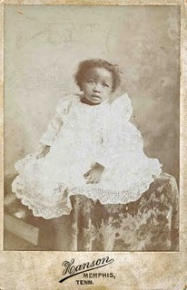
Photo at right young Lillian Hardin
Convinced that her only child had special talent, Dempsey sent Lil to Fisk University in Nashville to get her away
from the mean streets of Memphis and give her a good education. During the 1915-16 school year, Lil took college
preparatory courses (academics and music) but had to abide by Fisk's stringent rules, which prohibited profanity,
gambling, the use of alcohol and tobacco, and dancing between the sexes. [1]
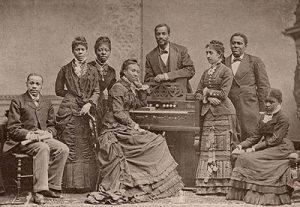
Fisk University Students, date unknown
Founded in 1865, Fisk University was one of the first black colleges in the
country. Six months after the end of the Civil War, just two years after the
Emancipation Proclamation, three men — John Ogden, the Reverend Erastus
Milo Cravath, and the Reverend Edward P. Smith — established the Fisk School
in Nashville. The school was named in honor of General Clinton B. Fisk of the
Tennessee Freedmen's Bureau, who provided the new institution with facilities in
former Union Army barracks near the present site of Nashville's Union Station.
In these facilities Fisk convened its first classes on January 9, 1866.
The reknowned Fisk Jubilee Singers became role models for young black Americans. They were one of the first black
music groups to record (Swing Low, Sweet Chariot, 1909). [2-S] Hear this historic recording here:
In June 1916, Lil returned to Memphis, a city bursting with World War I patriotism, but filled with violence and racial
strife. When Lil brought home a copy of the sheet music to “St. Louis Blues,” Dempsey called it “devils music” and
beat Lil with a broomstick. Lil never returned to Fisk. Dempsey and Lil packed their belongings, said goodbye to Memphis
and took a train to Chicago. [1]
But Chicago was also torn by racial strife. At the end of the WWI in 1918, thousands of African-American soldiers came
home from Europe expecting to enjoy the full rights of citizenship that they had fought to defend overseas.
[photo at right-Decorated WWI black soldiers]
But scarce housing and jobs heightened racial tensions, especially in urban
industrial cities like Chicago. Unemployed whites blamed working blacks for
their hardships. In the summer of 1919 race riots erupted in 20 U.S. cities.
The largest and most violent ones were in Chicago.
Photo above: White gang members hunt for African Americans during the
Chicago Race Riot of 1919.
Photo at right: White men and boys stand in front of a vandalized house
An editorial (7/29/1919) in the Chicago Daily Tribune, long considered
antagonistic to blacks, said in part: “White people resent the appearance of
colored people in white neighborhoods ... and take the position that the
"encroachment" of Negroes [causes] depreciation of property values."
The Chicago Defender, a black newspaper, called the riots “a disgrace to American civilization. America is known
the world over as the land of the lyncher and of the mobocrat. For years she has been sowing the wind and now she is
reaping the whirlwind.” (8/2/1919) [For race riot sources see below [3-S]
1917 – 1922: Chicago loves Hot Miss Lil
The South side of Chicago had an entertainment district similar to Beale Street in Memphis.
After reading newspaper accounts of police raids at clubs where African-Americans gathered
to listen to music, Dempsey kept a watchful eye on her daughter. By then Lil was a slender
attractive young woman with sparkling eyes and a winning smile. Photo at right
But Lil discovered the Jones Music Store, saw all the sheet music in the store window and wanted
every one of them. She went in the store and hummed a song she’d heard. The salesman began
to play it, but not to Lil’s satisfaction. She asked if she could try playing it. Amazed that such a
young girl could sight read that well, the owner offered her a job as a sheet music demonstrator.
Lil quickly accepted. Dempsey believed the $3/week Lil earned would help her return to Fisk University, but the job soon led
to other opportunities. The store owner, Mrs. Jennie Jones, was a booking agent, and musicians frequented the store.
One day, Jelly Roll Morton came in and sat down at the piano. Hearing Morton play had a profound influence on Lil, who
said: “[T]he place was rockin and the people were jumping up, and I was jumping higher than anybody. I imitated him
after that. I only weighed 85 pounds, and from then on you could hear all 85 of ‘em.” [1]
Lil began to embellish the sheet music and became the store’s star attraction. Lawrence Duhe and his New Orleans Creole
Jazz Band came in to audition for Mrs. Jones, who booked them into a club. But they needed a piano player. While it was
common for female singers like Alberta Hunter to front jazz and blues bands, female instrumentalists were rare. [3]
But Lil was different. She might wear frilly dresses, but her piano playing was far from frilly. Thanks to Jelly Roll Morton’s
influence, Lil played in a strong, hard-driving style. Her other asset? She could read music.
Duhe paid Lil $22.50/week to play in his band. None of the men could read music. Lil made them promise not to tell
her mother. But inevitably, Dempsey found out. She didn't want Lil playing in saloons, but Lil had no job skills other
than music, and Dempsey didn’t want her working as a cook or a maid, the most common jobs open to black women at
that time. So Dempsey decided to escort Lil home from work every night. From nine PM to one AM, Lil was “Hot Miss Lil.”
Then her mother took her home.
The Duhe band got a gig at Dreamland, a classier club, and Duhe imported a cornet player
from New Orleans, Joe “King” Oliver. But Oliver didn’t get along with the other players.
Photo at right, Joe “King” Oliver
Lil's dream job became a nightmare, and the band broke up. Lil returned to Dreamland,
where she often worked with Alberta Hunter, another famous Memphis native. Lil admired
Hunter’s vocal range, sense of style and her ability to make money.
Around that time Lil’s mother remarried, and Lil’s personal life also changed. She married Jimmy Johnson, a singer.
However, the marriage was brief, and Lil rarely talked about him after their divorce. [1]
King Oliver took over Duhe’s group, renamed it King Oliver’s Creole Jazz Band and asked Hot Miss Lil to play in it.
The King Oliver Creole jazz band became the hottest group in Chicago. Due to the
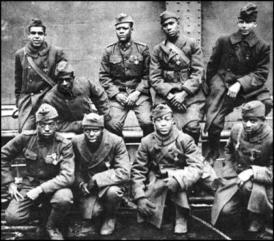


REAPING THE WHIRLWIND

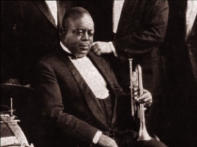
Lil returned to her job at Dreamland in Chicago. Oliver took his remaining band members back to Chicago and sent
for a young cornet player he knew in New Orleans. Some say Oliver sent Louis Armstrong a photo of Lil to entice him,
saying she played piano in the band, but when Louis played his first gig with the King Oliver Creole Jazz Band, Lil was
playing at Dreamland. Oliver took him there to meet her.
It wasn’t love at first sight on Lil’s part, but Louis fell in love with Hot Miss Lil. Photo at right
Drawn by financial concerns not romance, Lil rejoined the Oliver band and began to notice the
hot cornet player who was winning admirers with his big sound and freewheeling style. [1]
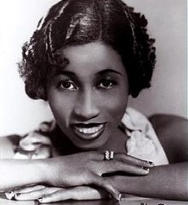
growing demand for recordings by African-Americans, King Oliver’s Creole Jazz Band
made some of the first jazz recordings for Gennett (1923), considered historic
recordings today, and others later for Okeh, Columbia and Paramount. On the cover,
King Oliver stands directly behind Lil, holding his cornet. Oliver’s band got a gig in
San Francisco, but problems arose and many of the players quit.
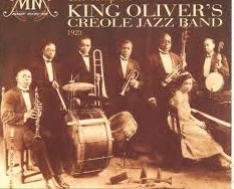
ROMANCE and a WEDDING
Romance bloomed. Lil divorced Jimmy Johnson, helped Louis win a divorce from his first wife, and on February 5, 1924,
Lil became Mrs. Louis Armstrong. [3] Lil felt his talents were wasted playing second cornet to Oliver and urged him to
leave the band. In 1924 they went to New York City where Louis got a job in Fletcher Henderson’s popular band, the
Black Swan Troubadours. Henderson’s wife, Leora Mieux Henderson, a trumpet player, wrote the arrangements but didn’t
perform with the band. [2] However, Leora later played in one of Lil’s all-women bands.
No one seemed interested in hiring Lil to play piano, so she returned to Chicago.
Determined to make Louis a star, she organized an 8-piece band, Lil’s Dreamland
Syncopators, featuring Louis on cornet. She also decided Louis needed to look like a star.
She taught him how to dress and got him a spiffy new suit. Photo at right, circa 1924
Ever the promoter, Lil Persuaded Okeh Records to hire a smaller group, The Hot Five,
for a recording featuring Louis Armstrong on trumpet, Lil Hardin on piano, Johnny Dodds
on clarinet, Johnny St. Cyr on banjo and Kid Ory on trombone. Photo below left.
The 1925 session featured four of Lil's songs, and is now considered the
most important recording of early jazz. In 1926 they did another session
that included Louis’s now-famous rendition of “Cornet Chop Suey.”
Halfway through “Heebie Jeebies,” Louis began scatting (singing non-sense
words and syllables). Considered the first scat recording, “Heebie Jeebies”
sold more than 40,000 copies within weeks of its release. An astounding
number in 1926. [1] Hear it here
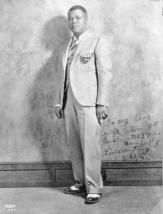
Between 1925 and 1927, recordings by the Hot Five, Hot Seven and Lil’s Hotshots (aka the Hot Five), including
Lil’s masterpiece “Struttin With Some Barbecue,” made musical history. [2] Louis and Lil became the “First Couple of Jazz.”
Although Louis was a fantastic musician and leader, Lil was the one who took care of businees and got him gigs.
Louis was the star and Lil was the star-maker. Despite their success, mindful that she still had no college degree, Lil
decided to go back to college. In 1928 Lil earned a degree from the Chicago College of Music, and in 1929 a
post-graduate diploma from the New York College of Music. [2] But all was not well in the Armstrong household.
Lil’s marriage to Louis was disintegrating.
1930s: It's Murder!
There is little doubt that Louis was the love of Lil’s life. Early on, she put up with his affairs, but as his fame grew, so did
his philandering. Louis’s mother and his adopted son Clarence lived with them in Chicago, but in 1925 Louis moved his
mother and adopted son into his mistress Alpha’s house in New Orleans. [1] Although the Depression derailed the careers
of many musicians, Louis’ career blossomed. In 1930 he got a job playing the Cotton Club in Culver City, CA, which gave
him added exposure on radio broadcasts. Lil went to visit him there, but their reunion was interrupted by the arrival of
Alpha. Weary of playing the role of abandoned wife, Lil returned to Chicago. [1]
Lil returned to Chicago, determined to focus on her own career. During the early 1930s the vivacious Hot Miss Lil
led two all-woman bands, The Creolians, and the Harlem Harlicans, which featured Dolly Jones on trumpet,
Leora Mieux (Henderson) on trombone, and Alma Scott (mother of jazz pianist Hazel Scott) on woodwinds. [2]
But other than the all-white female band led by glamorous Ina Ray Hutton, gigs for all-women bands,
including several talented all-woman black bands, were hard to find during the Depression.

In 1933 Lil was invited to play with an all male band based in Buffalo, NY, featuring
Jonah Jones on trumpet and George Clarke on tenor sax. “We all fell in love with Lil,”
Clarke later said. [1] For performances, Lil wore a glamorous white gown and a top hat,
and used a baton to direct the band. Photo at right
But the band never got the radio exposure that the Duke Ellington and Cab Calloway bands
received. Perhaps booking agents weren’t ready for a black female bandleader.
In 1935 the group disbanded. “I never could figure that out,” said Jonah Jones. “It was a
great band, one of the best I’ve ever worked with—and that’s saying a lot.” [2]
Lil returned to Chicago and organized another all-male band—Lil Hardin and Her Swing Orchestra—and became a vocalist.
Teddy Coleman played piano; Lil sang, wrote songs, arranged the music and in 1936 cut a record deal with Decca [1]
Lil wrote both lyrics and music for her songs. “Brown Gal” reflects her pride in her black heritage, and her scatting on
two of her songs, “Hi-De-Ho-Man” and "It’s Murder,” was slick. [hear "It's Murder" ]
The Decca releases were so successful, Lil took the band to New York in 1937 to record at the Decca studio. These records
were equally successful. Late that year, billed as the “swing queen,” Lil returned to Beale Street in Memphis to headline a
nightly show at the Palace for blacks. But Memphis was still a racially segregated city. At midnight she did a second show,
for whites only. [1]
In 1938 Lil did two record sessions for Decca with bands she organized, but the year was a difficult one. Although they had
been separated for years, Lil was in the midst of negotiating a divorce from Louis. Her somber mood is reflected in the title
of one of her songs: “Happy Today, Sad Tomorrow.”
In July, her mother died. More sorrow came when she learned that King Oliver had died penniless in Savannah. [1]
And, although the band members loved and admired Lil, promoters and ballroom managers were reluctant to hire her.
Not only was she female, she was black. Worn down by the stresses in her life, she agreed to a divorce from Louis,
waiving any claims to alimony. The most important collaboration in the history of early jazz came to an end. [1]
1940 -- 1960: Just for a Thrill
Lil recorded her final session at Decca with a new band that included her old friend Jonah Jones on trumpet. Lil played
piano, but her heart wasn’t in it. Louis had married Alpha, but soon began a much publicized affair with a young chorus girl,
Lucille Wilson. Five days after his divorce from Alpha in 1942, Louis married Lucille.
Now in her forties, Hot Miss Lil still had a sparkle in her eyes, but her zest for music was gone. Ever the entrepreneur, she
opened a restaurant in Chicago. Lil Armstrong’s Swing Shack featured a soul-food menu with specials like Boogie-Woogie
Stew, Bebop Black-Eyed Peas, and Divine Swine (ham or bacon). [1] Inspired by a Works Progress Administration sewing
class she’d taken, Lil decided to become a fashion designer. When she wasn’t at the restaurant, she worked on
clothing designs, targeting both men and women. And one man in particular: Louis.
She made suits and jackets for his performances, and Louis wore them proudly,
including the midnight blue tux he wore as King of Zulus at the 1949 New Orleans
Mardi Gras celebration. When Lil saw photos of Louis wearing her clothes, it made
her feel closer to him. [1]
Lil held a fashion show in New York, but once again she was ahead of her time. America wasn’t ready for a black fashion
designer. No matter how good the designs, white buyers wouldn’t purchase her line for white customers. Not until 1962
did Life Magazine feature black model Liz Campbell. [1] Disheartened, Lil closed her restaurant and found work
teaching piano, French, and general music. By 1950, she was largely invisible in the music world. She hadn’t released a
record for over a decade, and musical tastes had changed.
But in 1952 she decided to return to music and went to Paris, playing at Paris’s Jazz
Month celebrations and jazz clubs. After almost two years gigging in Europe, she returned
to Chicago in September 1953, but gigs there were scarce and jazz tastes were changing.
During the 1950s, race relations were tense. Black leaders were pressing for legal and
social reforms. And black jazz players like Dizzy Gillespie and Charlie Parker were playing
bebop. The only gigs Lil could get were playing the “oldies” of a by-gone era. [1]
In 1961, Lil was recruited by Riverside Records for a series of albums
titled “Chicago--The Living Legends.” Lil appeared on the third album.
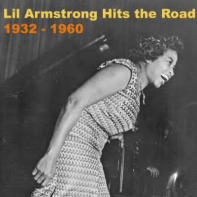
But the 50s ended on an up note when Ray Charles’s remake of Lil's song, Just For a Thrill, became a big hit.
This introduced Lil to a new generation of listeners who loved the way she blended sophisticated lyrics with the melody.
Others who recorded Just For a Thrill include Peggy Lee, Nancy Wilson, the Ink Spots, Aretha Franklin and
the J. Geils band. [1] Hear Ray Charles sing it
The 1960s: Living Legends
At the age of 61, she took three of her songs to the session in September
1961. Due to a mixup in scheduling, her band was combined with that of
Earl Hines. The album featured 40 minutes of Lil at her best. It was her final
recording, but it led to her appearance in a 1961 NBC-TV special:
Chicago and All That Jazz, one that drew approval from younger jazz fans.
Sometime later, the man who produced the Riverside albums, Chris Albertson, asked Lil to co-write her autobiography
with him. It’s not clear why, but after a while Lil ended the collaboration and continued to work on it on her own. By 1969,
she had completed four chapters, but the book was never published. [1]
In 1968, Lil played at the Top of the Gate in New York City. John S. Wilson interviewed her for a New York Times article,
calling her “a hearty woman with a bubbling personality, who plays piano and sings with a zest and assurance that
completely belie her age.” [4]
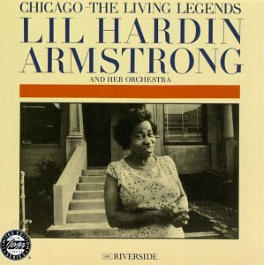
1971: A Most Wonderful Woman
The end of an era came on July 6, 1971, when Louis Armstrong died. Lil was devastated. Although separated for years,
they remained firm friends. More than husband and wife, they had been musical soul-mates, their offspring the music they
created together. Now he was gone.
Lil attended the funeral on July 9 along with 500 others, including his widow Lucille, his sister Beatrice, and hundreds of
music, film and political luminaries. A thousand fans stood outside listening to the service over loudspeakers. Millions more
watched on television. After the funeral, now 73 years old, Lil returned to Chicago, totally alone. Her only family members,
a few cousins, lived in Memphis. Seven weeks later, she was invited to participate in a memorial concert for Louis [1]
On August 27, 1971, thousands gathered for the noon concert at Chicago’s Civic Center Plaza. Chicago Tribune jazz critic
Harriet Choice, who had on several occasions spent time with Lil, spotted Lil and went to talk to her. When she asked for
an interview, Lil said, “We’ll talk later, honey.” [1]
Introduced by the master of ceremonies, Lil sat at the piano and began to play W.C. Handy’s St. Louis Blues. The audience
cheered. Inspired by her listeners, Lil smiled broadly. When the final chord came, Lil paused, her hands hovering over the
piano, and toppled to the floor. The audience gasped. Everyone on stage froze. Someone rushed to give her mouth-to-mouth
resuscitation, but it was too late. Lil was dead.
Her obituary appeared in the New York Times the next day. [8/28/1971]. Unlike Louis’s
funeral service, only a handful of people attended Lil’s funeral on August 29. There were no
reporters, no film or politcal luminaries, no TV cameras. The only media person there was
Harriet Choice, who came out of friendship not because an editor sent her.
Lil Hardin was buried in Lincoln Cemetery, Cook County, Illinois, and disappeared from the
jazz scene. Not until books began to be published about Louis, most by male authors, did she
regain some attention. Not until female authors published books about important jazzwomen
did Lil Hardin get the attention and respect she deserved.
John Hammond wrote: “One of the most loveable people that ever existed in music was Lil Hardin Armstrong, Louis’s wife
and protector during those early rough days in Chicago. [She] was no match for the vultures who surrounded Louis in the
most creative days of his career.” [1]
But Lil’s old friend and admirer Jonah Jones summed it up best: “I thought this was a most wonderful woman.” [1]
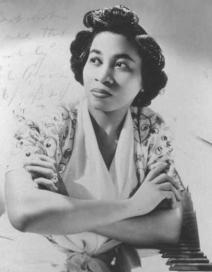
Lil Hardin was a jazzwoman pioneer, possibly the most important female musician in the history of early jazz. During the
1920s she played on many of the historic first jazz recordings, first with King Oliver’s band, and later on the Hot Five and
Hot Seven recordings with Louis Armstrong. She also composed many of the songs that later became jazz classics.
[see partial list of her songs, below]
Not until the 1970s did women win acceptance in [male] jazz bands. Prior to that, some performed with all-women groups,
but a woman’s presence in a male jazz band was rare. A notable exception: Melba Liston with Dizzy Gillespie’s band in the
1950s. [See Melba Liston's bio). Even today it is relatively rare for women instrumentalists to play in male jazz groups.
There are those who say that Lil would not have achieved success without being married to Louis Armstrong. The facts
indicate otherwise. In the early years, Lil set aside her own ambitions to facilitate his career. By all accounts, when Louis
came to Chicago at 17, he was a shy overweight teen with a country bumpkin haircut, rumpled clothes and little confidence
in his abilities. Were it not for Lil, his genius might never have been heard. Recognizing his talent, she launched his solo
career and worked hard to ensure that he was seen in clubs and heard on records. She helped him notate his musical ideas,
arranged record sessions, published their music and promoted his stardom.
Lil's strength was not as a piano soloist. In the early recordings, she provides a strong rhythmic foundation. But she was a
consummate musician with a terrific ear who could reproduce anything she heard on her piano and, unlike the men in
King Oliver’s band, including Louis, Lil could read and notate the music. As James Dickerson put it: “She wasn’t the soul of
the band, she was the brain of the band.” [1]
Her relationship with Louis had its ups and downs, but Louis believed in Lil. When others criticized her, he praised her piano
playing and musicianship. He often said that he had attained success by listening to Lil’s repeated advice:
“Play second trumpet to no one.” [1] Although they went through some rough times, they remained good friends for life.
Role models and Inspirations
Lil admired many musicians, but three stand out as having a profound impact. One early influence was Jelly Roll Morton;
after hearing him, Lil adopted his hard-swinging style and began improvizing. Alberta Hunter was another. Hunter dressed in
flashy clothes, and Lil recognized the impact this had on audiences. Most of all, she admired Hunter's business sense and
ability to make money, something Lil began to emulate. Perhaps the biggest inspiration of all was Louis Armstrong. They
were musical collaborators at home and in clubs and recording studios. After their separation and divorce, many of the
songs Lil wrote were thinly veiled vehicles to express her love for him.
Obstacles
For a black woman to achieve the success Lil Hardin attained was unheard of in the early years of the 20th Century,
especially in the South. Although she encountered both race and gender bias, her perseverance never wavered. The
outstanding musicians she worked with, including Johnny Dodds, Red Allen, Zutty Singleton, Buster Baily, Lovie Austin,
and Sidney Bechet, recognized her talent. As her friend trumpeter Jonah Jones said: Lil Hardin was a most wonderful woman.
Legacy
Even in her day, Lil served as a role model and inspiration for other young jazzwomen. An independent feisty woman, she
achieved success in the male-dominated world of early jazz. Her talents live on in her many recordings and the 150 songs
she composed, some like Struttin With Some Barbeque, Just for a Thrill, Perdido Street Blues, are considered jazz classics.
COMMENTARY
Lil Hardin Armstrong: A Partial Discography
Note: The Hot Five used the name Lil’s Hot Shots when recording for Vocalion. The Hot Seven added a tuba and drums,
thanks to advances in recording equipment.
King Oliver’s Creole Jazz Band, Gennett Record Company, 1923.
The Hot Five (“My Heart,” “My Heart Will Always Lead Me Back to You,” “(Yes) I’m in the Barrel,” and “Gut Bucket Blues”),
Okeh Records, 1925.
The Hot Seven (“Don’t Jive Me”), Okeh Records, 1928.
Four recordings for Decca: Lil Hardin Armstrong and Her Swing Orchestra (“Just for a Thrill,” “Brown Gal,” “Doin’ the Suzie-Q,”
“It’s Murder,” and “My Hi-De-Ho Man”) 1936.
Lil Hardin Armstrong and Her Swing Orchestra (“Born to Swing,” “(I’m on a) Sit-Down Strike for Rhythm,”
“Bluer Than Blue”) 1937.
Lil Hardin Armstrong and Her Swing Orchestra (“Let’s Get Happy Together,” “Happy Today, Sad Tomorrow,” “You Shall Reap
What You Sow,”) 1938.
Lil Hardin Armstrong and Her Swing Orchestra (“My Secret Flame”), 1940.
Riverside Records, 1961 Chicago —The Living Legends (“Boogie Me,” “Eastown Boogie,” and “Clip Joint”)
Television appearances: 1961 NBC-TV special: Chicago and All That Jazz
A partial list of Lil Hardin songs
Just For a Thrill (recorded by Ray Charles and many others);
Struttin' With Some Barbecue (recorded by Louis Armstrong, Pete Fountain,
Al Hirt, Billie Holiday, Earl Hines, Bobby Hackett, Doc Severinson, The Gene Krupa Band, and many others);
Perdido Street Blues (recorded by Louis Armstrong, Frank Sinatra, Johnny Dobbs and others);
I'm Not Rough (recorded by Louis Armstrong, The J. Geils Band, and others)
King of the Zulus, Skit Dat De Dat, Lonesome Blues, My Sweet Lovin' Man, Satchel Mouth Swing,
Happy Today, Sad Tomorrow, Hi De Ho Man, New Orleans Stomp, It's Murder, Everything's Wrong, Ain't Nothing Right,
Born To Swing, My Secret Flame
SOURCES: Lil Hardin
1. Just for a Thrill: Lil Hardin Armstrong, First Lady of Jazz, by James L. Dickerson, 2002
2. Jazzwomen 1900 to the Present, Sally Placksin, 1982
3. All About Jazz: Lil Hardin Armstrong biography
4. John S. Wilson, New York Times, 12/10/1968
5. Obituary, New York Times, 8/28/1971
6. see also Dave Radlauer's excellent article about Lil Hardin.
Historical Sources:
1-S Ida B. Wells
2-S Fisk University Jubilee Singers
3-S Jazz Age Chicago Notable events, 1919 Race Riots.
4-S Gangs and the 1919 Chicago Race Riot, John Hagedorn, Ph.D
© copyright 2010 Susan Fleet
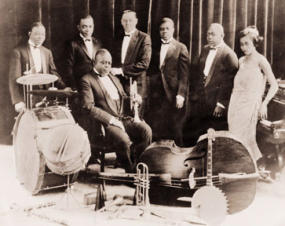
In the photo at left: Lil standing, King Oliver is seated
with his cornet, Louis Armstrong stands to the right of
the man standing beside Lil.
Days later, Louis was arrested for smoking marijuana and went to jail. Johnny Collins got him a suspended sentence, but
in return, Collins demanded a percentage of his earnings. Louis returned to Chicago and organized a new band, but after a
nightclub brawl in which several patrons were hurt, Louis took the band on the road and wound up in New Orleans.
Lil went there to visit, found him living with Alpha, and told him: “I think it’s best if you go your way and I go my way and
we’ll remain friends."[1]
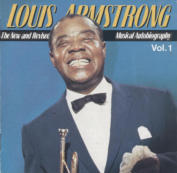


WELCOME TO SUSAN FLEET’S WEBSITE
AUTHOR, TRUMPETER, MUSIC HISTORIAN

Copyright Susan Fleet 2007 All rights reserved None of the materials on this website may be reproduced or
transmitted by any means, including photocopying, recording or the use of any retrieval system without
permission. For permission, email Susan via the contact page











